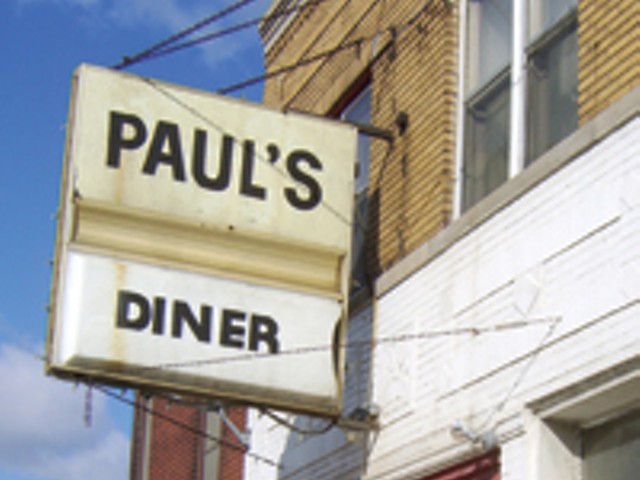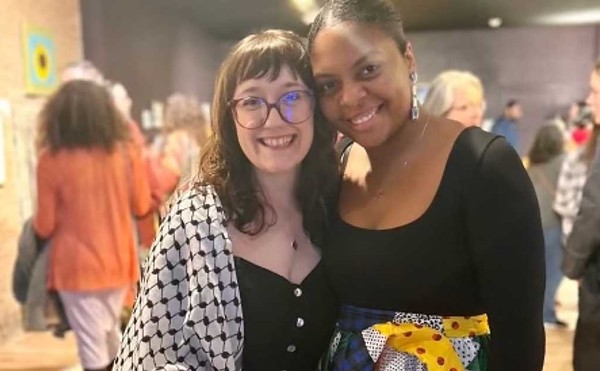Book Beat owner, artist and collector Cary Loren is always on the lookout for a good story. He makes his living tracking down obscure hardcovers and well-worn paperbacks for our community, and we love him for it. But this here is the story of one rarity — a person, not a thing — that kept him searching for years.
Douglas Juleff, otherwise known as "Douglas of Detroit," was one of the long-lost masters of physique photography, a genre of picture-taking that coincided with the golden age of male fitness from the 1930s to the '50s. "A master retoucher," that's what scholar and contemporary photographer Reed Massengill calls Douglas. Massengill should know: He's researched and written about all there is on classic physique photographers. But it was Loren who caught up with Douglas, the man himself, living like way too many exceptional Detroit talents from another era, in obscurity. A police raid in oppressive times, nearly 50 years earlier, had destroyed his art and life.
Loren first heard about Douglas in the late 1980s, while visiting Don Whitman, a photographer and owner of Western Photographic Guild in Denver. Loren had already been collecting figure photography for almost a decade. "If you find him," Whitman told Loren then, "you will find a treasure."
After searching for about five years, Loren had given up. But as good stories go, there was a twist: One day in the early 1990s, Douglas walked through the door at Book Beat in Oak Park, a seventysomething gentleman, kind, reserved and an immaculate dresser in a polyester suit with huge lapels and polished shoes. Loren recognized him immediately, and the two became close friends.
Back then, in the early 1990s, Loren had just hung an exhibit at Book Beat of one of Douglas' better-known contemporaries, "Bruce of L.A."
"He wanted to sell me some of his Bruce photos," Loren recalls. "I told him I'd rather see his photos."
Douglas would come by bus to the store regularly, and Loren took him out to lunch. "We'd talk about his work and maybe he'd buy some books, and then I'd drive him home." Loren tried to get Douglas to discuss why he quit making art so many decades earlier, while he was still very successful, but he'd only shake his head in response, his eyes wet with tears.
In the '40s and '50s, Douglas had worked in Hudson's photo department. On the side, he made some extra cash and earned a reputation by becoming immersed in the body-building craze, not as a contender, but as a photographer. Around that time, Jack LaLanne, "the Godfather of Fitness," was young and healthy, as entertaining as he was motivating. Lifters and athletes ruled publications like Strength and Health, Body Beautiful and Adonis. Both straight men and gay men — "pep boys," Douglas called them — ogled the glossy pages. So did a sizable group of gay men feigning heterosexuality, one would imagine.
According to Massengill, Douglas helped to launch the careers of such local athletes as Vic Seipke (Mr. Michigan of 1951) and Jim Park (Mr. America of 1952) by taking studio portraits for the magazines. But his personal work revealed more.
He shot striking nude photos of Detroit's weightlifting hobbyists and professionals, many of whom he met at a local gym owned by his friend. He wasn't alone in that trade: Physique photographers Bruce of L.A. and Lon of New York, with whom Douglas exchanged works often, also enjoyed commercial success working for publications while delving into the private side of portraiture, selling nude male images underground at road shows to the gay market. His stuff, like Bruce's and Lon's, stradled two worlds.
In fine art, of course, nude modeling is one of the oldest traditions. By the 1900s, there was already a rich history in photography, including early erotic daguerreotypes, Wilhelm Von Gloeden's effeminate Donatello-eqsue boys from the 1890s, and George Platt Lynes' tableaus, begun in the 1930s.
But during the McCarthy era, nude imagery was considered obscene. It was illegal to send anything like that through the mail. Early in his career, Douglas had taken a photo of a Detroit police officer with a nightstick and an erection (the irony). Several years later, in the late 1950s, it landed on the captain's desk.
His house was ransacked. All his prints and negatives were confiscated by the police, and his father, whom Douglas lived with at the time, assisted by handing over whatever he could find. Douglas was traumatized. Many of his models' lives were destroyed as well, and the guilt settled in good. Shamed, Douglas quit taking pictures altogether. The few prints and negatives he had left in his studio at Hudson's — where he occasionally shot, developed and printed portraits for clients after hours — are all that remain.
But with Loren's attention, his photography has come to light. German publisher Jaansen put out a book of Douglas' work in 1998, a year before he died at age 82 from kidney failure, as part of a series American Photography of the Male Nude 1940-1970. Now, in the modest back room gallery of Book Beat, Loren presents Douglas' first solo show of physique photography, accompanied by a few portraits by his contemporaries.
Gazing at Douglas' photos, it's obvious that he viewed his subjects as more than hunks or health nuts. While Bruce focused more on soft-core titillation (he was a fan of backless chaps on bare skin), in Douglas' images, masculine bodies were the building blocks of design. The contours of a male figure created strong shadows, and the long vertical line of a well-postured silhouette suggested a charged sense of formality. He even moved beyond cliché references to portraiture by using a modern bamboo shade as a backdrop, rather than a draped curtain or sheet. The shade's texture and linear quality enhances the sense that his prints were like drawings rather than photos.
He was a skilled darkroom technician, competent in burning and dodging and multiple exposure. But his lighting "is like chiaroscuro," Loren says.
Douglas didn't blatantly focus on distinct muscle groups. One image presents a towering man backlit brilliantly as if the sun was setting behind a skyscraper. Douglas empowered his subjects as if they literally were body builders — architects of their own masculinity. He shot these men as if they were modern buildings to be worshipped rather than chiseled sculptures referencing antiquity. Each model stands proud; with an expression, nearly impenetrable yet not necessarily stony.
There's something inherently sad about these men who seek to stand apart from the crowd. In their quest for perfection, they end up achieving anonymity. Their bodies are all equally fantastic, and their faces — our true markers of individuality — forgettably handsome.
On the other hand, today's competitive male bodybuilders are morbid parodies of humanity. They're grotesque, hypertrophying vicitims from some early Cronenberg film, if seen through a fun-house mirror. Athleticism in general has become totally surreal. Standing in such strong contrast, Douglas' vintage photos represent vitality in art and in life that barely exists anymore.
Douglas of Detroit runs through the end of the summer at Book Beat, 26010 Greenfield Rd., Oak Park; 248-968-1190.
Rebecca Mazzei is Metro Times arts and culture editor. Send comments to [email protected]




